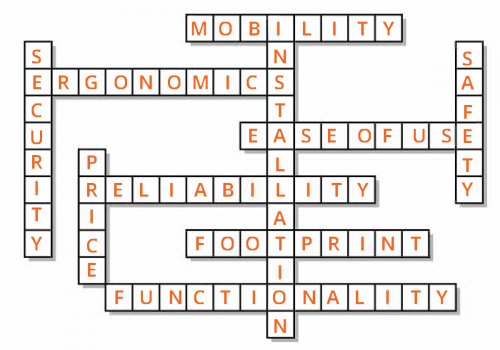
With over 20 years of experience in creating AV systems, Nomad has identified 20 AV Design Factors that can guide the design and integration of AV systems, to ensure the expectations of end users are met or exceeded.
Nomad fully considers and weighs all system features against these design factors, many of which are contradictory, and then helps customers consciously decide what’s most important for their end users. Only through skill acquired over multiple years of experience can this be accomplished.
Here’s the essential list of the 20 Design Factors:
⋅ Intuitive Ease of Use / Training ⋅ Security
⋅ Reliability ⋅ Paper Space
⋅ Safety ⋅ Retractable / Appearance
⋅ Minimal Footprint / Compact ⋅ Flexibility
⋅ Component Selection ⋅ Ease of Production
⋅ Ergonomics ⋅ Line of Sight
⋅ Functionality ⋅ Ease of Service & Modification
⋅ Height Adjustability (ADA) ⋅ Installation / Infrastructure
⋅ Mobility ⋅ Cool Factor
⋅ Face-forward Presentations ⋅ Price
In the beginning, this list started with 10 factors, and over the years it has grown to 20 that must be considered when creating AV systems. A new design factor is added to the list when requests are so frequent, or so profound, that it goes beyond including a feature in a single system. It is then added for consideration in all future designs.
Take, for example, the introduction of paper space to our list of AV design factors.
An early version of one of our AV systems had limited paper space on top of the podium due to the inset placement of the confidence monitor that allows face-forward presentation. The monitor was inset to ensure that it would not interfere with the presenter’s line of sight to the audience. Once presenters explained they needed more space to lay out binders and notes, we took that feedback into account when designing our current model of the Nomad LT.
We knew that minimal footprint, line of sight and face-forward presentation were all still major design factors to be considered, and consequently we added paper space into the equation as well. By designing a tilting monitor mount, we mitigated line of sight concerns, freed space on top of the podium for notes, and allowed face-forward presentations all while maintaining a minimal footprint for the podium.
As you can see, feedback and requests need to be taken seriously but also vetted against how the system will be used and how the system can be built. The ramification of not fully considering the design factors may throw off the balance of achieving the equilibrium needed to create a user-friendly AV system.
Yin and Yang
 At first glance, the 20 factors are fairly straightforward. However, as mentioned above there are accompanying considerations for each factor that come into conflict with each other. Sort of like yin and yang.
At first glance, the 20 factors are fairly straightforward. However, as mentioned above there are accompanying considerations for each factor that come into conflict with each other. Sort of like yin and yang.
You’ve probably seen the Chinese symbol for yin and yang (shown at right). In a definition by Wikipedia, the idea of this Chinese principle is that “seemingly opposite or contrary forces may actually be complementary, interconnected, and interdependent.”
The same rings true in designing an effective AV system. These factors must be balanced against the opposing ones to create a system that will operate optimally for users and consider the constraints of the design.
The Importance of Balance
As we work with customers to design solutions that meet their needs, requests for new, non-standard features regularly come up. We try to honor most requests; however, every feature concept is looked at through the lens of design factor balance. Feature requests are thoroughly vetted against the current design factors and any possible ramifications are discussed with our customers. Everybody agrees upon the inclusion of requested features, with an understanding of the potential consequences of the decision. Nomad has learned from experience it’s important to review any possible effects and address those up front with the end users.
Using the 20 Design Factors is a way to keep the end user top-of-mind while designing a fully-functioning AV solution. Every detail from furniture design to component integration must be thought through to ensure an effective, efficient solution and positive experience for the end user.
Consider, for example, security of the AV components within a system versus ease of service. It’s important to have security to keep the entire AV system operating correctly. Going to lengths to protect the system is important. However, if the customer is only worried about security, ease of service and repair becomes extremely difficult. When the factor of security is weighed against being able to access those components for repairs, an excessive amount of security (intrusive locks, noisy alarms, security keys that can become lost, etc.) must not interfere too severely with the access for repair or maintenance. It’s that fine line of Yin and Yang to ensure that the system will be safe and serviceable. If the AV designer doesn’t examine that balance, the system could be either vulnerable to theft or extremely difficult and time-consuming to support.
Or, let’s compare the design factors of ease of use and functionality. An AV designer typically wants to make a system that includes all the features (i.e., bells and whistles) the end user requests. However, if the designer does that, the system could be overwhelming and too complicated to operate. If the system is too complicated, end users are not going to use it. Going down an extreme path too far in one direction (with all the bells and whistles) throws off other design factors, like ease of use. With thoughtful, up-front consideration, the right balance of functionality, flexibility, and ease of use can be achieved.
Overall, in each of the situations noted above, it doesn’t matter how much is spent on the system (whether $100 or $1 million), the end result is wasted time and money if the system does not work for end users and enhance their ability to present. Costly oversights can be avoided by using the 20 Design Factors to guide the effective implementation of an audio visual presentation solution.
That’s a Wrap for Part 1
Nomad’s stringent set of 20 Design Factors is used in the manufacture of every Nomad AV option and solution, allowing us to build a balanced, user-friendly system. When Nomad designs an AV system, we take into account not only how it will be integrated, but also every item on a customer’s wish list for usability and convenience. Nomad has taken the time to think through the details of ensuring that all factors are considered and properly weighed when engineering audio visual systems.
Be sure and stop back at our blog for the next two installments that will discuss in depth the 20 important design factors of AV systems and the considerations to take when designing an AV system.
Want to learn more right now? Head over to our website (spoiler alert!) to read up on all 20 Design Factors. If you’re creating an AV design or purchasing an AV system, it is well worth your time to review. At Nomad, we’ve thought through the details, so you don’t have to.
If you review the 20 Design Factors and then would like to know more, we can do a virtual demonstration or bring a system to you for an on-site demo. Contact us here.
